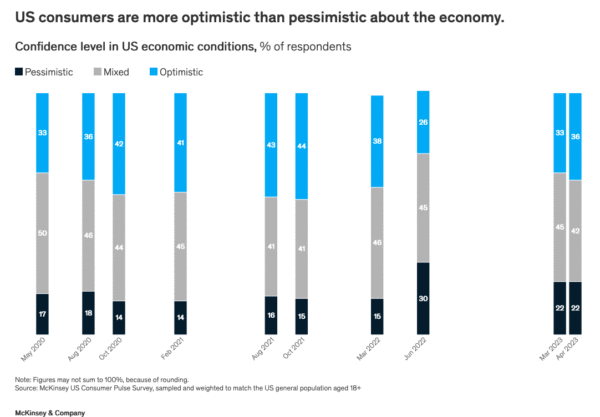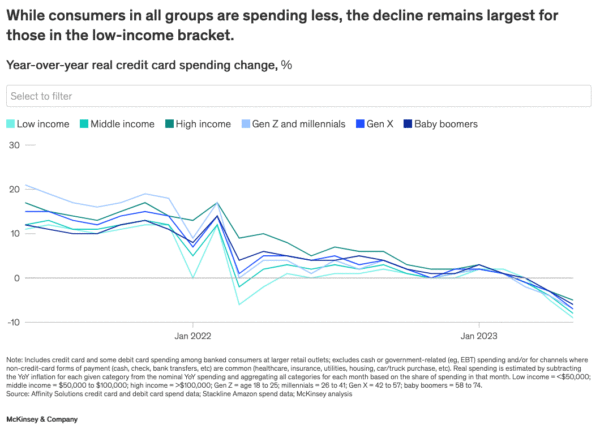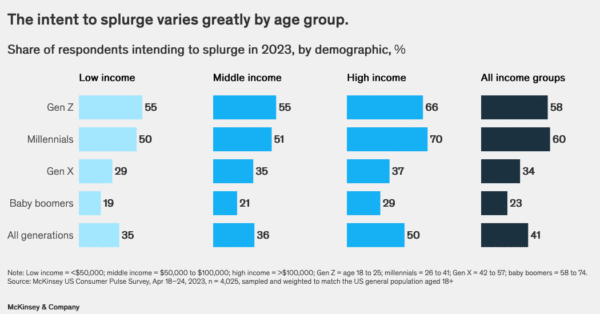The state of the US consumer: July 2023
July 29, 2023

By Christina Adams, Kari Alldredge, Sajal Kohli, and Andrew Pitakos
Despite some glimmers of optimism last quarter, consumer spending across demographic groups—and many retail segments—continues to decline. Here’s the latest research from our ConsumerWise team.
After signs of improving economic sentiment in the spring, consumer spending seems to be in a summer slump. Across age and income groups, American consumers continue to spend less than they did a year prior—except on travel. Real year-over-year spending has declined for the third month in a row, while for the first time in more than two years, nominal spending growth is now negative as well.
Consumer confidence
As optimism rises, spending continues to decline. As noted in our two previous updates, the spring months heralded a modest increase in US consumers’ optimism. (ConsumerWise data on consumer confidence are updated on a quarterly basis.) But for the third month in a row, overall real year-over-year spending across all age and income groups has declined, as the next chart shows.

For both real and nominal spending, the year-over-year change is negative. In May 2023, consumer spending (as measured by credit card spending) declined in real terms by more than 6 percent versus one year ago, with nominal spending growth turning negative for the first time in more than two years.
Among the segments we track, only travel saw a slight increase, with real year-over-year growth of 1 percent. This is due largely to the steamship and cruise lines subsegments, which are seeing a year-over-year growth rate of 40 percent in real spending—and which also experienced outsize growth in the month prior.

Real spending, by demographic
Real spending continues to decline across all demographic groups. For the second month in a row, we see a negative change in real year-over-year spending for all income and age groups. By income level, the decline is still greatest among low-income consumers (–9 percent). By age, the year-over-year decline (of –7.1 percent) is steepest among Gen X, as well as Gen Zs and millennials, and even larger among low-income Gen Z and millennials (–9.5 percent versus one year ago). While baby boomers and higher-income consumers also report lower rates of spending, the declines are less significant: –6 percent and –5 percent, respectively.

Intent to splurge, by demographic
Millennials’ intentions and actions are at odds. As we noted last month, consumers’ intent to splurge does not reflect their actual habits. This is especially true of millennial consumers. They were the most likely across age groups to report plans to splurge last quarter. But in May, the growth in millennials’ real year-over-year spending was negative—at more than –5 percent.

Intent to splurge, by category
Consumers may be holding back on splurging. Our latest sentiment survey, conducted in Q2 2023, suggests that consumers intended to splurge in multiple categories. However, our real spending data from May reveals that consumers did not do so last quarter. In May, just one retail segment, travel, saw an increase in real year-over-year spending (of 1 percent).

Will US consumer spending continue to decline next month? Will American consumers spend on something besides travel this summer? Watch this space for monthly updates on US consumer spending, plus quarterly updates on US consumer sentiment. Please contact us for more information.
This update was edited by Daniella Seiler, an executive editor in the Washington, DC, office.



























